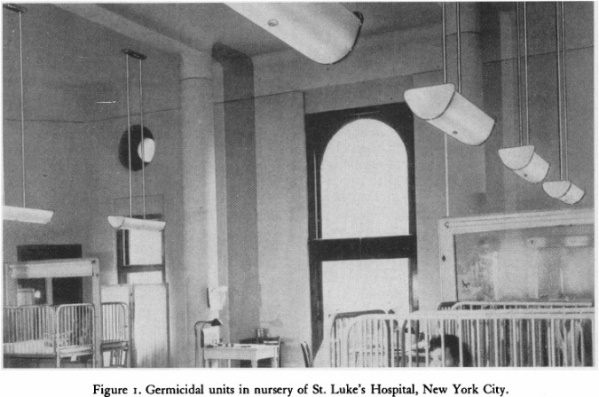Nous exploitons les propriétés germicides des UV-C pour décontaminer l’air et le matériel, sans danger pour les personnes.
Nous exploitons les propriétés des UV-C pour décontaminer l’air et le matériel, sans danger pour les personnes.
UVGI (Ultraviolet Germicidal Irradiation) technology is fast and effective, without chemicals. It has been used in laboratories for over 150 years.
The particularity of ON-LIGHT is to be able to control this light power to exploit the germicidal potential of UVGI, outside the standardized use of laboratories (sterilization devices) to transpose it to public places, with an operation in the presence of people, continuously and in complete safety.
Light and its properties
Light and its properties
Light is made up of many wavelengths, some visible, some not.
Our eye only perfectly sees the visible part of the electromagnetic spectrum, from 400 nanometers (nm) in wavelength (blue light) to 700 nm (red light).
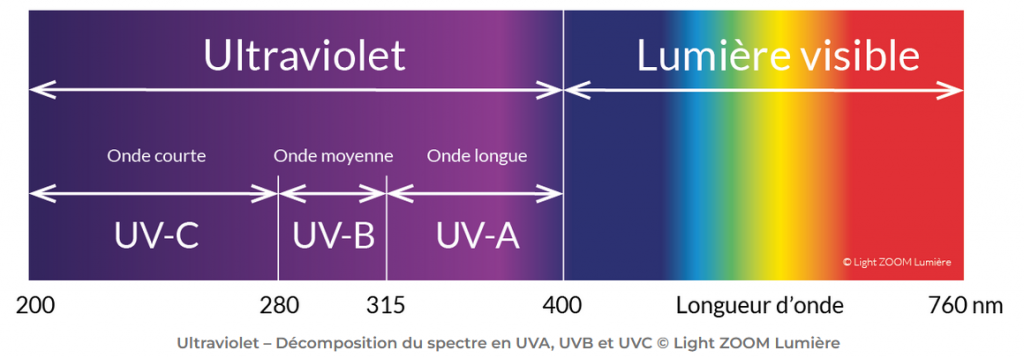
If infrared are perceived by the heat they give off, ultraviolet rays are not immediately felt but their harmful effects on the skin and eyes are real.
UV-A makes us tan. By their action at the basal level, they cause a reaction of protection of the cells of our skin by the synthesis of melanin responsible for tanning.
UV-B, more energetic but less penetrating than UV-A, helps us to synthesize Vitamin D and helps to fight against psoriasis and eczema.
It is the penetrating nature of these two rays (UV-A and UV-B) that makes them harmful to the skin (cell degeneration), in the event of overexposure.
UV-C that we exploit have a very short wavelength. They are quickly absorbed on the surface but have enough energy to penetrate very small pathogens and have a germicidal effect on viruses, bacteria and spores.
It is on this property that our air, object and surface decontamination systems are based.
Mécanismes d'inactivation
Mécanismes d'inactivation
Very energetic, UV-C rays are absorbed by the genetic material of pathogens due to their small size: viruses from 20 to 200 nm and bacteria from 1000 to 2000 nm.
This absorption forms nodes in the genetic code of pathogens (dimerization) and makes reading and expression of the genome impossible.
The viruses are then unable, once in a cell, to express their genetic code and are destroyed by the cells.
Bacteria, on the other hand, cannot create the proteins they need.
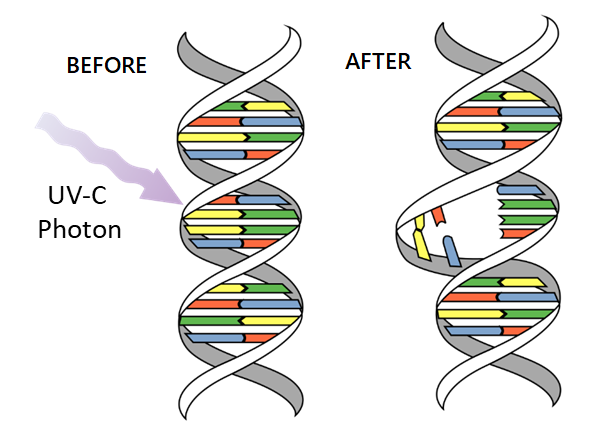
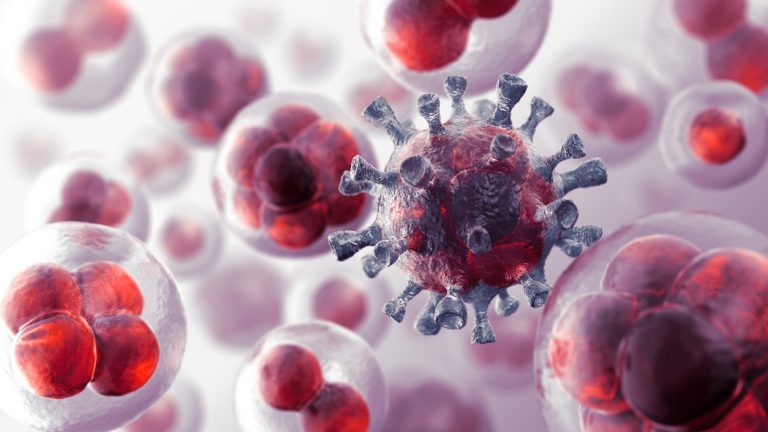
Result: exposed to UV-C rays, bacteria die and viruses are inactivated, they can no longer infect their hosts or reproduce.
This technique makes it possible to fight against SARS-CoV-2 (Covid-19), tuberculosis, influenza, avian flu, etc.
Continuous operation
Continuous operation
Most pathogens emitted by people are emitted by their breathing.
The air that comes out of our lungs is 35°C, warmer than the surrounding air. It rises and carries pathogens with it.
The upper area of the parts is therefore the right place to destroy them.
When the hot air passes through the germicidal beam, the pathogens are destroyed.


Sur le marché, les solutions de décontamination de l’air par UV-C sont les plus efficaces mais pas forcément les plus connues.
Sur le marché, les solutions de décontamination de l’air par UV-C sont les plus efficaces mais pas forcément les plus connues.
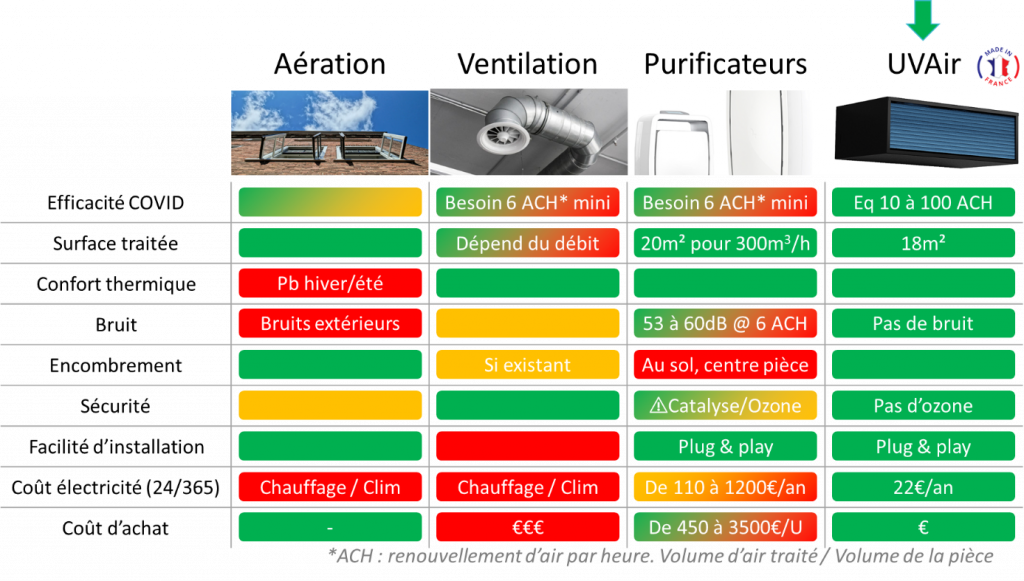
Comparison with aeration, ventilation and filtration
Comparison with aeration, ventilation and filtration
Ventilation is the simplest solution: open the windows.
However, it is not always effective (it depends on temperature differences, locations, outside wind, etc.) unless it consists of create a strong current of air.
But this is not always possible or desirable (particularly because of temperature, noise, pollution, safety problems, etc.).
Ventilation is often put forward.
However, it is generally not effective lack of sufficient flow.
To fight against pathogens, you need 10+ ACH of healthy air (exterior air or highly treated recirculated air), which requires specific installations, very different from the air conditioning / ventilation usually installed.
These ventilations are generally only found in operating theaters.
Even in hospitals, standard air conditioners rarely provide more than 2 ACH for energy consumption issues (air heating/cooling, humidification, etc.).
Filtration via purifiers has developed.
HEPA filters are very effective at trapping particles, including pathogens.
On the other hand, filters only treat the air that passes through.Efficiency is therefore closely linked to throughput.
In an office of 12 m2 (3x4m) it takes a flow of about 300m3/h.
In a classroom of 60m2 (6x10m): 1500m3/h.
Such speeds result in significant energy consumption (300m3/h = 50 to 70W) and above all significant noise (depending on the model, it is equivalent to that of a spinning washing machine or a vacuum cleaner), which is unbearable in the long term.
Most purifiers are then quickly turned off or set to low speed and their efficiency is zero.
Added to this is the problem of their maintenance: pre-filters and filters to be changed regularly, sensors to be cleaned... A maintenance-free purifier is inefficient, like a vacuum cleaner if the bag is never changed.
Also be careful with systems that generate ozone or radicals (catalysis system also called PCO (Photo Catalytic Oxidation): they create very reactive and harmful chemical species, and are very strongly discouraged.
Advantages of the UV-AIR air decontamination system developed by ON-LIGHT
Our UV-Air system has been developed to offer an innovative and long-lasting decontamination solution in the face of unsatisfactory traditional solutions in terms of efficiency, maintenance over time and comfort for users.
Our UV-Air air decontamination device is:
- Efficient: a part is secured in less than 10 minutes thanks to our patented technology.
- Low energy consumption: 1W/m2 protected.
- Without filter: no consumables to buy or replace.
- Noiseless.
- Emission-free: it does not emit Ozone or any other chemical species.
- Very easy to install.
We are also proud to be able to specify that this product is 100% Made in France.
It was designed and developed by ON-LIGHT and it is manufactured in the Auvergne-Rhône-Alpes region.
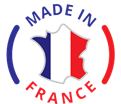
UVGIs have always been the most relevant solution for neutralizing pathogens.
UVGI (Ultraviolet Germicidal Irradiation) was discovered nearly 150 years ago by Messrs. Blunt & Downes who noticed that certain types of light killed bacteria.
This effect remained largely unexplained despite knowledge of DNA as early as 1860 (but not of its structure).
In 1930, Gates will prove that it is nucleic acids, the “letters” of the genetic code, which are sensitive to UVGI (germicidal UV).
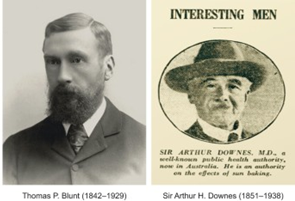
UVGI systems for air decontamination were developed in the USA in 1930, to fight against many respiratory diseases, fatal because without treatment.
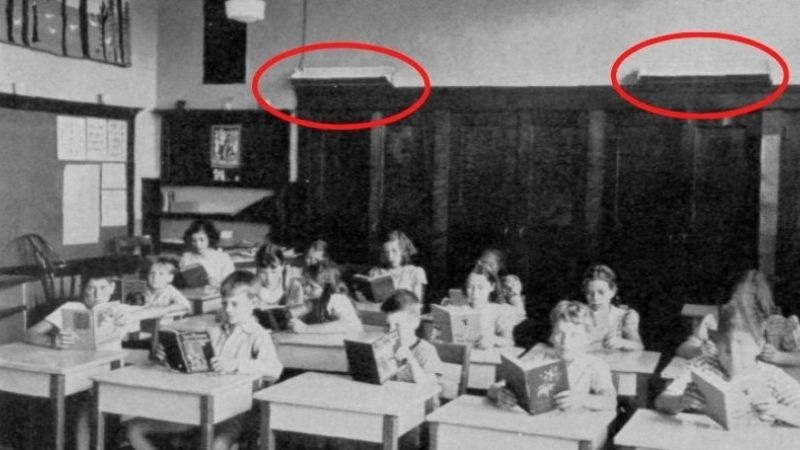
At that time, measles was regularly responsible for the death of 5% of children during epidemics.
Tuberculosis also wreaked havoc at all ages with a 30% mortality rate.
There was no vaccine, no antibiotics and therefore no way to protect against viral or bacterial diseases.
Only prevention was possible.
This is why, in 1946, the 1400 largest American hospitals as well as 300 school groups were equipped with these new devices. They have significantly reduced disease transmission with an 85% reduction in the spread of measles and 80% for tuberculosis.
With the war then appeared the antibiotics, in particular penicillin, which made it possible to fight effectively against the bacterial diseases.
Then, the 1960s were marked by the appearance of the first vaccines such as measles in 1957.
